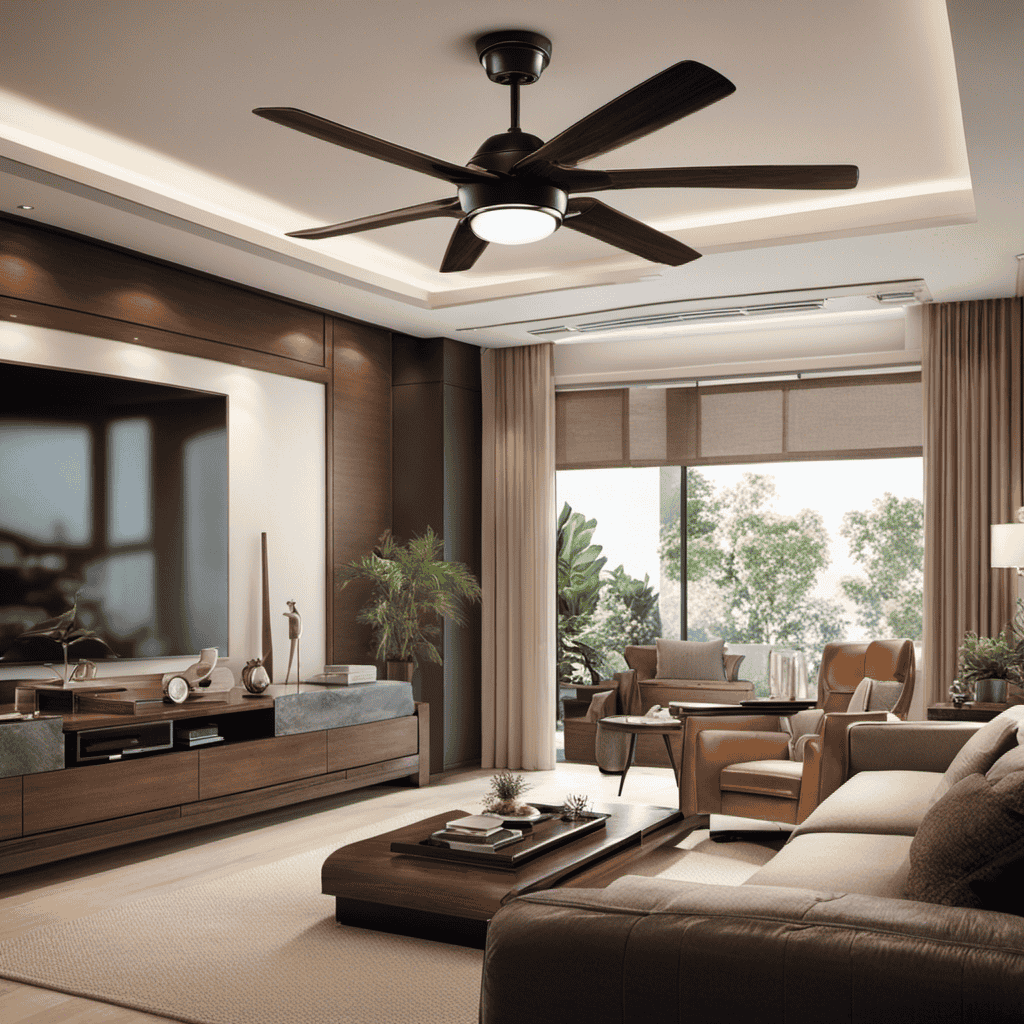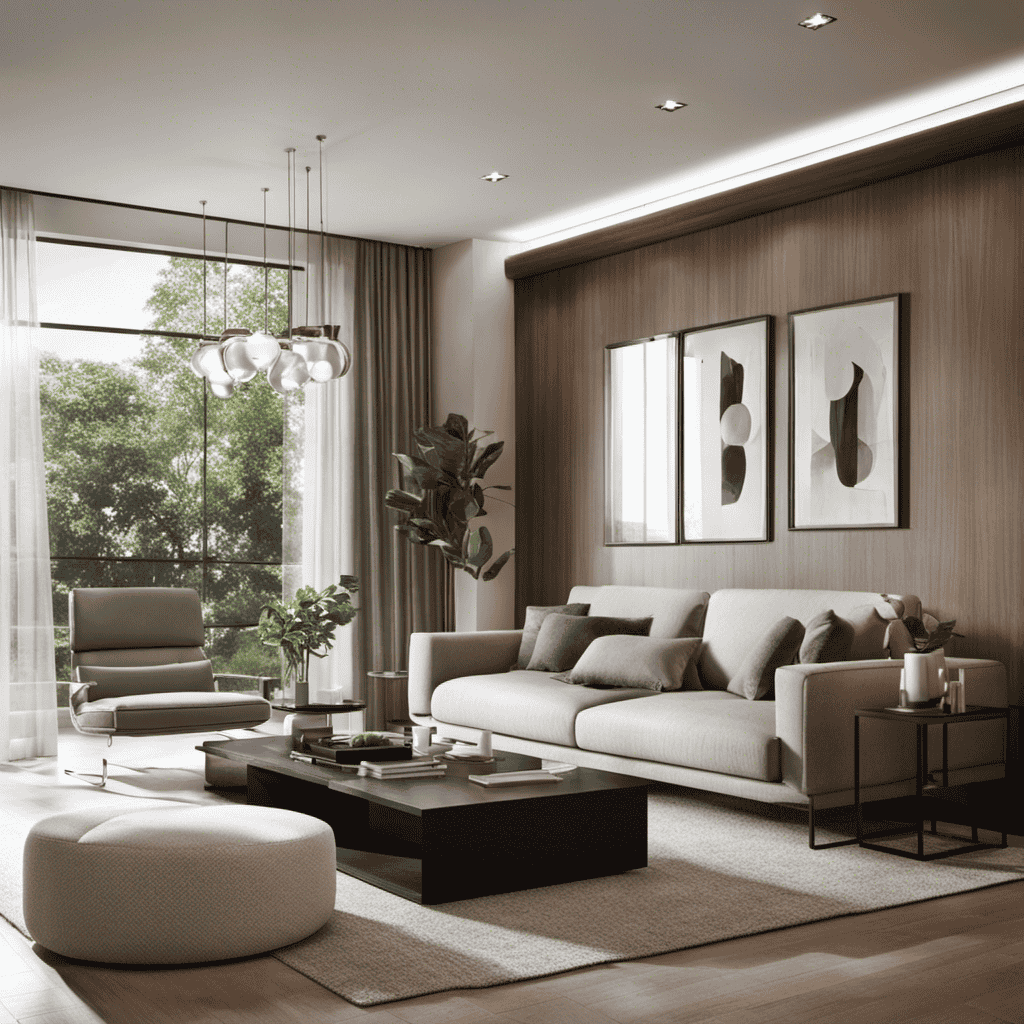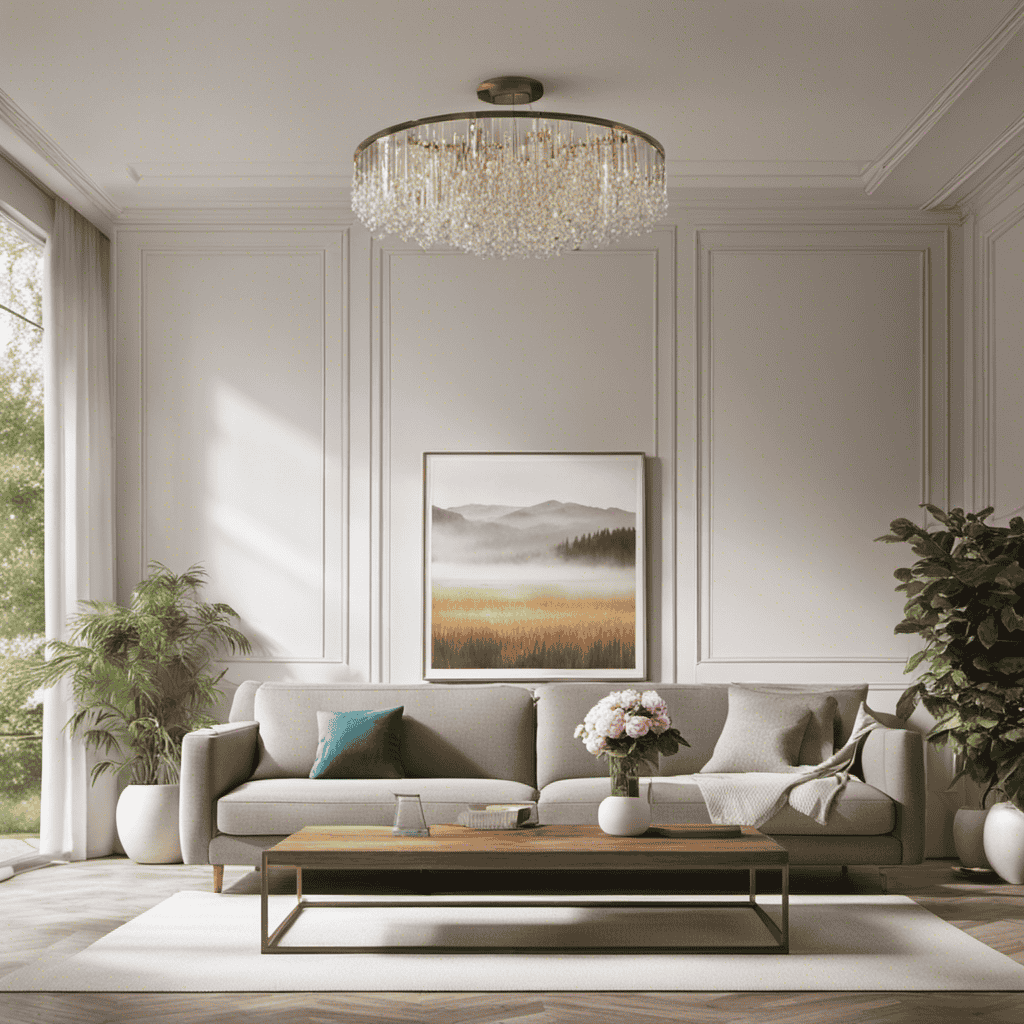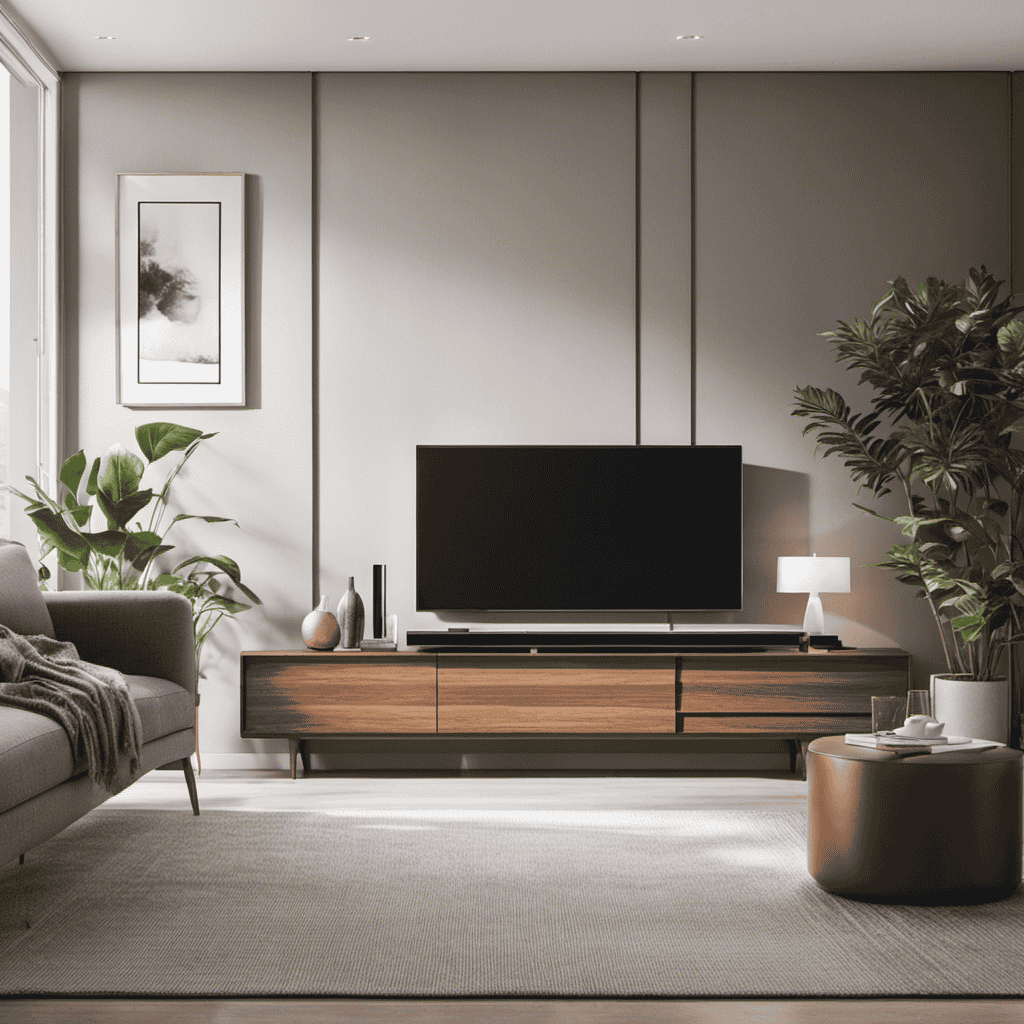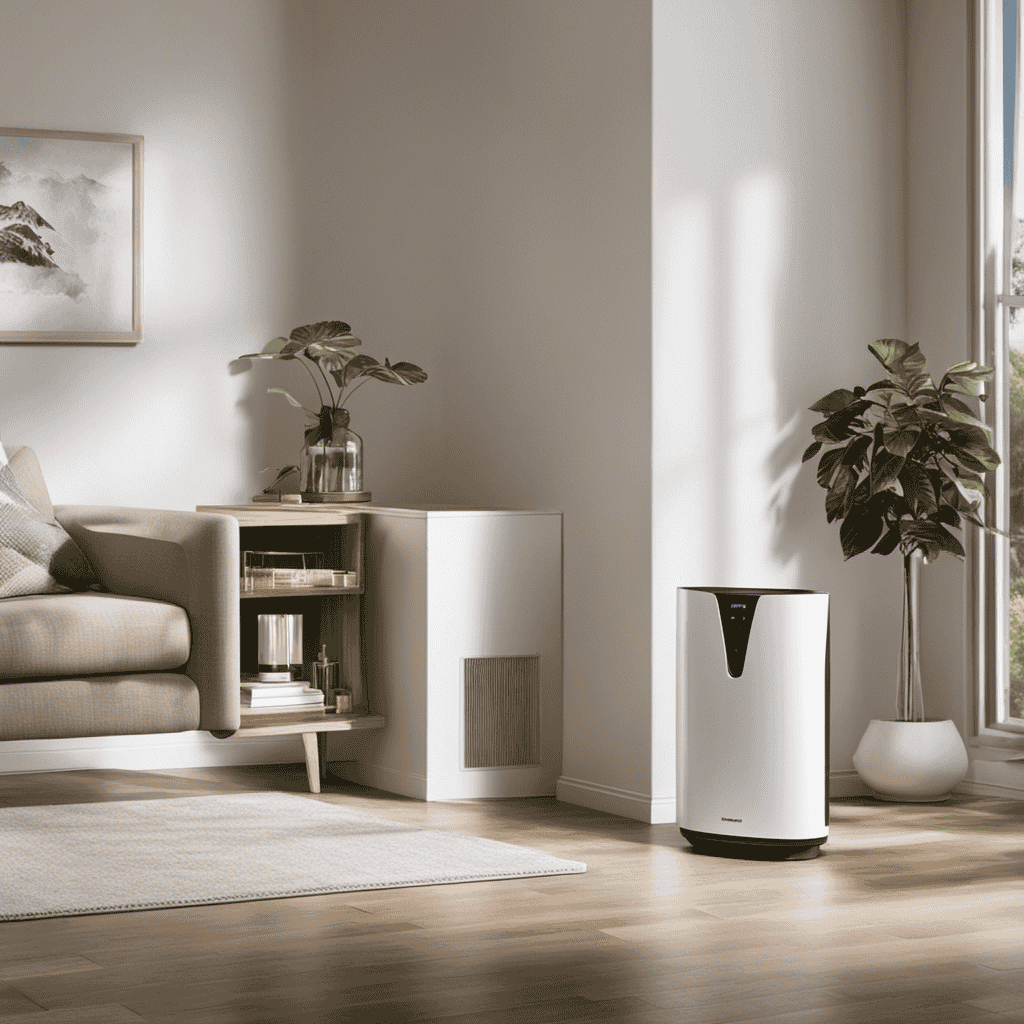Maintaining and Troubleshooting Your Air Purifier
As an air purifier enthusiast, I know the importance of keeping your air purifier in top shape. It’s like having a loyal companion by your side, working tirelessly to rid your home of dust, allergens, and odors.
But just like any relationship, it requires maintenance and troubleshooting. In this article, I’ll guide you through the ins and outs of maintaining and troubleshooting your air purifier, ensuring that it continues to provide you with clean and fresh air.
So let’s dive in and discover the secrets to a long-lasting and efficient air purifier.
Key Takeaways
- Regularly clean and replace filters to improve efficiency and prolong the lifespan of the air purifier.
- Address strange odors or noises promptly by cleaning or replacing filters, and consulting the user manual or customer support.
- Ensure proper airflow and ventilation by cleaning vents, opening windows, and placing the air purifier in a location that allows for optimal air circulation.
- Follow the manufacturer’s instructions for overall maintenance and care, and avoid using harsh chemicals or abrasive materials when cleaning.
Understanding the Parts of Your Air Purifier
To understand how your air purifier works, you’ll want to familiarize yourself with its various parts. Proper maintenance of these components is essential for optimal performance and longevity of your air purifier.
The first component to consider is the pre-filter. This is the initial line of defense against larger particles such as dust and pet hair. Its function is to capture these particles before they reach the main filter, extending the life of the filter and improving its efficiency. Regular cleaning or replacement of the pre-filter is necessary to prevent clogging and maintain its effectiveness.
Next, we have the main filter, which is responsible for trapping smaller particles like pollen, mold spores, and bacteria. It is typically made of high-quality materials such as HEPA or activated carbon. The main filter should be replaced according to the manufacturer’s recommendations to ensure optimal air purification.
Another important component is the fan or motor. This is what circulates the air through the purifier and facilitates the filtration process. Regular cleaning and lubrication of the fan blades or motor bearings may be necessary to prevent malfunctions and ensure smooth operation.
Lastly, some air purifiers come equipped with additional features like ionizers or UV germicidal lamps. These components provide extra purification capabilities by neutralizing airborne contaminants or killing bacteria and viruses. Understanding the functions of these additional components will help you utilize them effectively and maintain their performance.
Cleaning and Replacing the Filters
Make sure you regularly clean and replace the filters in order to maintain the efficiency of your air purifier. The filters in an air purifier are crucial for capturing and removing airborne particles, such as dust, allergens, and pet dander. Over time, these filters can become clogged and less effective, which can reduce the overall performance of your air purifier.
To ensure that your air purifier continues to work optimally, here are some cleaning techniques and filter maintenance tips to keep in mind:
-
Cleaning techniques:
-
Use a soft brush or vacuum cleaner attachment to gently remove dust and debris from the surface of the filter.
-
If the filter is washable, rinse it under running water and allow it to air dry completely before reinstalling.
-
Filter maintenance:
-
Check the manufacturer’s instructions for recommended filter replacement intervals. Some filters may need to be replaced every 3 to 6 months, while others may last up to a year.
-
Keep a record of when you last cleaned or replaced the filter to ensure that you are staying on top of maintenance.
Regular cleaning and filter replacement will not only improve the efficiency of your air purifier but also prolong its lifespan. By following these simple maintenance steps, you can enjoy cleaner and healthier air in your home.
Common Issues and Troubleshooting Techniques
When it comes to maintaining your air purifier, two common issues that you may encounter are filter replacement frequency and strange odors or noises.
Knowing the recommended filter replacement frequency is crucial to ensure that your air purifier continues to function effectively.
Additionally, if you notice any strange odors or noises coming from your device, it is important to address them promptly as they could indicate a potential problem that needs to be resolved.
Filter Replacement Frequency
The filter should be replaced every three to six months to ensure optimal performance of your air purifier. Regular filter replacement is essential for maintaining clean and healthy indoor air quality. Here are some key points to consider when it comes to filter replacement:
-
Increasing Longevity:
-
Clean the pre-filter regularly to remove large particles and debris, which can extend the lifespan of the main filter.
-
Consider using a washable or reusable filter to reduce the frequency of replacements and save money in the long run.
-
Cost-effective Options:
-
Look for high-quality filters that offer a good balance between performance and price.
-
Consider purchasing filters in bulk or subscribing to filter replacement services to save money and ensure you always have a fresh filter on hand.
Strange Odors or Noises
Have you noticed any strange odors or noises coming from your air purifier? If so, it’s important to address these issues promptly to ensure the optimal performance of your device.
Strange odors can indicate a problem with the filter or the presence of contaminants in the air. To eliminate odors, you should regularly clean or replace the filters as recommended by the manufacturer.
Additionally, noises from the air purifier can be a sign of malfunctioning parts or a loose connection. In such cases, it is advisable to consult the user manual or contact customer support for assistance.
Remember, a properly functioning air purifier should operate quietly, ensuring a peaceful environment.
Now, let’s move on to maintaining proper airflow and ventilation to maximize the effectiveness of your air purifier.
Maintaining Proper Airflow and Ventilation
To ensure your air purifier is working effectively, you should regularly clean the filters and vents. This is an important part of air purifier maintenance and plays a crucial role in improving air quality.
Here are some tips to help you maintain proper airflow and ventilation in your air purifier:
-
Clean or replace filters: Over time, filters can become clogged with dust, allergens, and pollutants. It’s recommended to clean or replace them according to the manufacturer’s instructions. This will ensure that your air purifier can effectively capture and remove contaminants from the air.
-
Check and clean vents: Vents can also accumulate dust and debris, which can obstruct airflow. Regularly check and clean the vents to ensure proper ventilation. A clean vent allows for better circulation and distribution of purified air throughout the room.
-
Ensure proper placement: Proper placement of your air purifier is essential for optimal performance. Make sure it’s placed in an area with good airflow and away from obstructions. This will help prevent air stagnation and improve the efficiency of your air purifier.
By following these maintenance tips, you can ensure that your air purifier continues to provide clean and fresh air, improving the overall air quality in your home or office.
Dealing With Unpleasant Odors
When it comes to dealing with unpleasant odors, there are various odor elimination techniques that can be employed. These techniques can effectively eliminate odors and improve the overall air quality in a space.
However, it’s important to first identify the common odor sources in order to effectively target and eliminate the odors.
Odor Elimination Techniques
There’s a simple technique you can try to eliminate odors from your air purifier. One of the most effective ways is to use activated charcoal filters. These filters contain a substance that helps absorb and neutralize odors, leaving your air smelling fresh and clean.
Additionally, you can also consider using ozone generators. They release ozone molecules that can break down and eliminate odor-causing particles.
When it comes to odor detection, pay attention to any unusual smells coming from your air purifier and investigate the source of the odor. It could be due to mold or mildew growth, pet dander, or even cooking odors.
By using the right odor elimination techniques, you can ensure that your air purifier continues to provide you with clean and fresh air.
Now that we have covered some effective odor elimination techniques, let’s move on to the common odor sources that you may encounter in your air purifier.
Common Odor Sources
One of the most common odor sources in an air purifier is the buildup of pet dander. Pet odors can be quite challenging to deal with, especially if you have multiple furry friends in your home.
The air purifier’s filters are designed to capture and remove these particles from the air, but over time, they can become clogged with dander, leading to unpleasant smells. To effectively eliminate pet odors, it is essential to regularly clean and replace the filters.
Additionally, identifying and eliminating smoke smells is another common concern. Smoke particles can linger in the air and settle on the air purifier’s surfaces, causing a persistent odor. To tackle this issue, wiping down the purifier’s exterior and using an air purifier with activated carbon filters can help in removing smoke smells effectively.
Addressing Noisy Operation
To address noisy operation, you should check if the air purifier’s filters are dirty or clogged. When the filters become dirty or clogged, they can restrict the airflow, causing the fan to work harder and create more noise.
Here are some troubleshooting steps you can take to reduce noise levels:
-
Inspect and Clean the Filters: Remove the filters from the air purifier and check for any visible dirt or debris. If they are dirty, gently vacuum or wash them according to the manufacturer’s instructions. Cleaning the filters regularly will help maintain optimal airflow and reduce noise.
-
Check for Obstructions: Ensure that there are no obstructions in the air purifier’s intake or exhaust vents. Sometimes, objects or dust accumulation can block the airflow, leading to increased noise. Clear any obstructions and ensure proper ventilation.
Following these troubleshooting steps should help resolve any noise issues with your air purifier. By ensuring that the filters are clean and there are no obstructions, you can improve the efficiency and reduce noise levels.
Now, let’s move on to the next section where we will discuss how to extend the lifespan of your air purifier.
Extending the Lifespan of Your Air Purifier
If you want to extend the lifespan of your air purifier, you should make sure to regularly replace the filters according to the manufacturer’s recommendations. This is crucial for maintaining optimal performance and ensuring that the air purifier continues to provide clean and healthy air in your home or office.
Filters play a vital role in trapping and removing airborne particles such as dust, pollen, pet dander, and smoke. Over time, these particles accumulate on the filter, reducing its effectiveness and potentially causing strain on the air purifier’s motor. By replacing the filters on a regular basis, you can increase the efficiency of your air purifier and prolong its lifespan.
Additionally, it is important to clean or replace the pre-filters if your air purifier has them. Pre-filters help capture larger particles, preventing them from clogging the main filter. By maintaining clean filters and pre-filters, you can ensure that your air purifier operates at its best, providing you with cleaner, fresher air for years to come.
Tips for Optimal Performance
Regularly cleaning and replacing filters is crucial for ensuring the optimal performance of your air purifier. By maintaining your air purifier, you can improve air quality and ensure that it continues to function effectively. Here are some tips for achieving optimal performance:
-
Clean the pre-filter: The pre-filter is the first line of defense against larger particles like pet hair and dust. Regularly vacuuming or washing the pre-filter will prevent these particles from clogging the main filter and allow for better airflow.
-
Replace the HEPA filter: The HEPA filter is responsible for capturing smaller particles like allergens and pollutants. It is recommended to replace the HEPA filter every 6-12 months, depending on usage and air quality. This will ensure that your air purifier continues to provide clean and fresh air.
-
Monitor the air purifier’s performance: Keep an eye on the airflow and noise level of your air purifier. If you notice a significant decrease in airflow or an increase in noise, it may indicate a problem with the filters or other components.
By following these maintenance tips, you can ensure that your air purifier operates at its best. However, there may be instances where professional help is needed.
In the next section, we will discuss when it is appropriate to seek assistance from a professional.
When to Seek Professional Help
If you experience any major issues with your air purifier that you are unable to resolve on your own, it is advisable to seek professional help. While many common problems can be solved through DIY methods, there are certain situations that require the expertise of a trained technician. Here is a table that highlights when it is appropriate to try fixing the issue yourself and when it is best to call in a professional:
| When to DIY | When to Seek Professional Help | Finding Reliable Professionals |
|---|---|---|
| Replacing filters | Strange noises or vibrations | Ask for recommendations |
| Cleaning the exterior | Frequent breakdowns | Check online reviews |
| Adjusting fan speed | Electrical issues | Verify credentials and certifications |
| Checking power connections | Poor air quality improvement | Seek referrals from friends or family |
| Resetting error codes | Malfunctioning controls or buttons | Contact local HVAC companies |
When attempting to fix minor issues, like replacing filters or cleaning the exterior, it is generally safe to do it yourself. However, when faced with problems such as strange noises, frequent breakdowns, or electrical issues, it is best to leave it to the professionals. To find reliable professionals, ask for recommendations from friends or family, check online reviews, and verify their credentials and certifications. Additionally, contacting local HVAC companies and seeking referrals can help you find the right technician for your air purifier needs. Remember, investing in professional help ensures that your air purifier is efficiently maintained and functioning optimally.
Frequently Asked Questions
Can I Use My Air Purifier in a Room With High Humidity?
Using an air purifier in a room with high humidity can cause damage. High levels of moisture in the air can affect the performance and effectiveness of the purifier.
Excessive humidity can lead to the growth of mold and bacteria, which can clog the filters and reduce airflow. This can result in a decrease in the purifier’s ability to effectively clean the air.
It is important to consider the humidity levels in your room before using an air purifier.
How Often Should I Clean the Exterior of My Air Purifier?
I clean the exterior of my air purifier every two weeks to keep it functioning properly. Regular cleaning is essential for maintaining optimal air quality and preventing dust and dirt buildup. By removing any accumulated debris, I ensure that my air purifier continues to operate efficiently.
In addition to cleaning the exterior, it’s also important to follow other maintenance tips, such as replacing filters as recommended by the manufacturer.
What Are the Potential Health Benefits of Using an Air Purifier?
Using an air purifier can have numerous potential health benefits. It helps to remove airborne particles such as dust, pollen, and pet dander, which can trigger allergies and asthma. By reducing the presence of these allergens, air purifiers can improve indoor air quality and alleviate symptoms.
Compared to other air cleaning methods, air purifiers are efficient and require less maintenance. However, it’s important to note that there may be potential drawbacks, such as ozone generation in some models.
Can I Use Scented Oils or Air Fresheners With My Air Purifier?
Sure, using scented oils or air fresheners with your air purifier can be harmful.
While they may seem like a quick fix for unpleasant odors, they can actually compromise the effectiveness of your purifier.
Scented oils and air fresheners release volatile organic compounds (VOCs) into the air, which can cause respiratory irritation and worsen indoor air quality.
It’s best to stick to using your air purifier as intended, without any additional fragrances or scents.
How Long Does It Take for an Air Purifier to Effectively Clean the Air in a Room?
It usually takes about 30 minutes to 2 hours for an air purifier to effectively clean the air in a room, depending on the size of the room and the air purifier’s capacity. Factors such as the level of pollutants and the air purifier’s settings also play a role.
Regular maintenance and troubleshooting of your air purifier can help ensure optimal performance and clean indoor air.
Conclusion
In conclusion, maintaining and troubleshooting your air purifier is crucial to ensure clean and healthy air in your home.
By understanding the different parts and regularly cleaning and replacing filters, you can effectively address common issues and keep your purifier running smoothly.
Proper airflow and ventilation, as well as dealing with odors and noise, are also important factors to consider.
By following these tips and seeking professional help when needed, you can extend the lifespan of your air purifier and enjoy optimal performance, like a well-oiled machine purifying the air around you.




